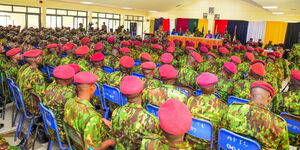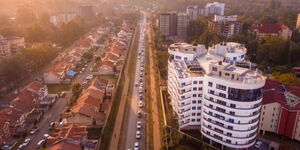Engineers and site supervisors employed different techniques and tricks to build the 27-kilometre Nairobi Expressway running from Mlolongo to Westlands.
Former President Uhuru Kenyatta launched the elevated highway in October 2019, with some officials reporting that the project was conceived after Chinese officials encountered traffic snarl-up from the Jomo Kenyatta International Airport (JKIA).
According to one of the site engineers, Fredrick Kojo, the construction of the road involved laying proper drainage systems, setting foundations, erecting piers and laying the road.
Kojo explained that the process was subdivided into four key sections to ensure efficient and timely execution.
The Nairobi Expressway project was undertaken as a Public Private Partnership with the China Road and Bridge Construction Corporation (Kenya) (CRBC) on a build-operate-transfer model. It cost north of Ksh62 billion.
Drainage System
Speaking to Former Citizen TV reporter Enock Sikolia through his YouTube channel, Kenyan Historian, Kojo disclosed that after surveying and identifying the site of construction, drainage was the first part engineers involved in construction had to address.
Site engineers used generators to identify drainage and water systems to prevent intermittent water shortages.
"Areas around JKIA had large pools of water. What we did was to set generators in place and to know where we had existing drainage systems, especially along Mombasa Road and surrounding areas, Kojo explained.
"So that we started pumping this water, we pumped according to the design we then channelled the water to existing drainage systems," he added.
They then contracted the government through the Ministry of Water to lay down the water pipes afresh.
Nairobi Expressway Foundation
According to engineers, setting up the foundation was key to building the elevated road. To ensure its firmness, the engineers deployed drilling machines, rotary drilling bits and cranes to break the rocks.
After drilling and excavation, concrete piers were built. They were five meters in diameter and 10 meters deep.
"We had to make sure the underlying bedrock was a good one. If we did not have favourable soil lying underneath, then we replaced that. The concrete for the foundation we had to sure was strong enough to hold the beams and piers," Kojo detailed.
This was done to ensure the beams were held firmly above the ground.
Erection of Piers
Piers are the vertical beams erected to hoist the road above the ground. The piers were constructed in six types; single columns, double columns, single columns frame piers, double columns piers and three columns piers.
To build the piers, steel reinforcement cages were placed and hoisted then steel modes were fixed around the cages. Concrete was then powered into the cages giving the columns their shape. The steel modes were removed once the concrete dried up.
Explaining the erection of single piers on some sections of the road, outgoing Transport Cabinet Secretary James Macharia noted that it was essential due to available space.
"When they used single piers, they had to dig deeper and reinforce the foundation. The same technique was used in building the Standard Gauge Railway," Macharia explained.
Laying of the Road
Engineer Kojo played a key role alongside other Chinese experts in laying the road from Mlolongo to James Gichuru Road in Westlands. He explained different soil types were used in laying the road structure.
The amassed huge hills of soil were compressed before the laying of bitumen.
"Engineers ensured concrete maintained its quality from factory to laying on the road. This was done by maintaining the right amount of temperature, measuring soil texture and mixing it to perfection," Kojo explained.
Staffing
According to Infrastructure PS Paul Maringa, staffing was key to the execution of all the works involved in building the road. Maringa added that the team hired to help in Nairobi Expressway construction was divided into sets of teams that ensured 24 hours delivery.
"Supervision with Chinese team was very critical. Tha was the standard principle of construction. They employed over 4500 Kenyans in different sectors. They were then broken down into work gangs."
"Each gang had a supervisor who had strict timeliness and clear job description to ensure timely delivery of the project," Maringa added.
The planting of flowers along the 27-kilometre road was assigned to a different team. Other experts were also contracted in building the toll stations, fixing different additional amenities on the road such as street lights and road signs.
After construction was done, Moja Expressway was contracted to maintain the road and oversee its operations. The company was tasked to assist in recouping the money pumped into the project before handing it over to Kenya National Highway Authority (KeNHA).
In July 2022, Uhuru launched the road after months of trial. He argued that the project was key to opening up opportunities in the country.
"Since we opened the road for public trials in April, it now takes between 15 and 24 minutes to drive from Mlolongo in Machakos County to Rironi in Kiambu County. Before the expressway, that journey would take at least three hours which is the equivalent of flying to Addis Ababa and back," Uhuru stated.












